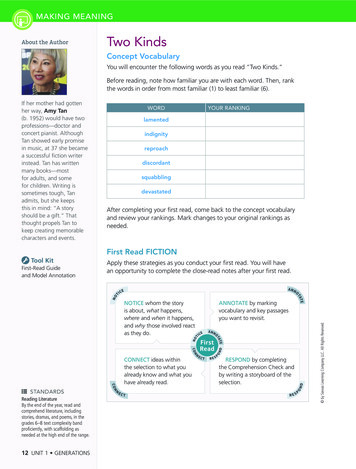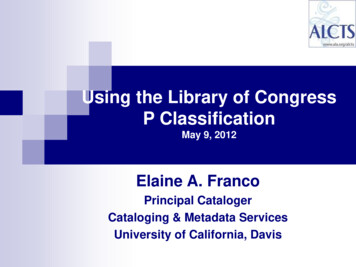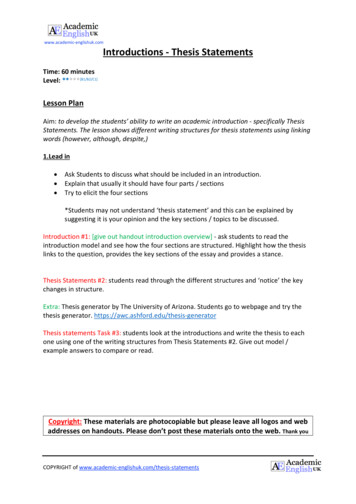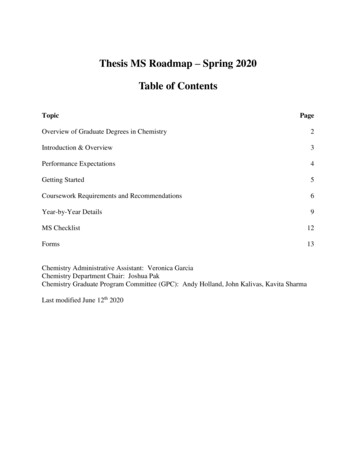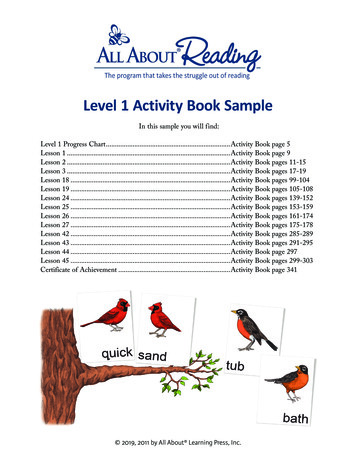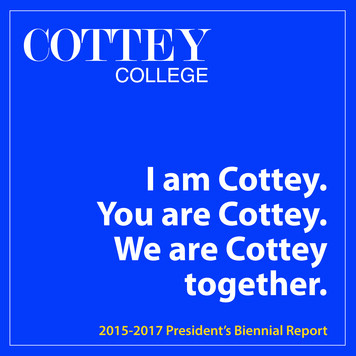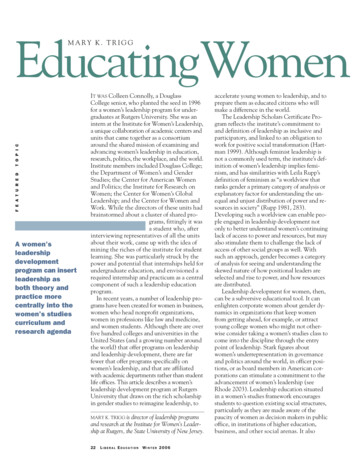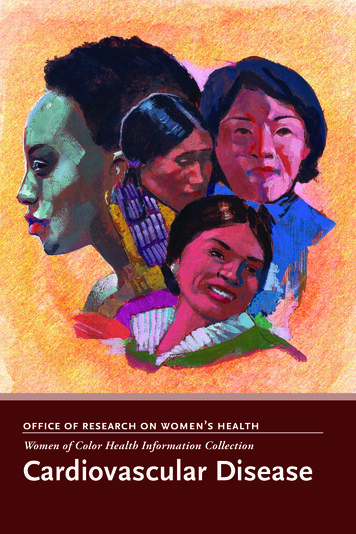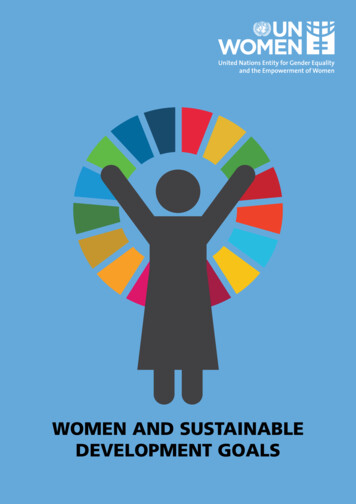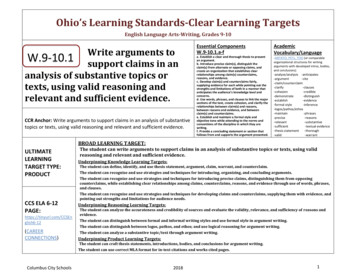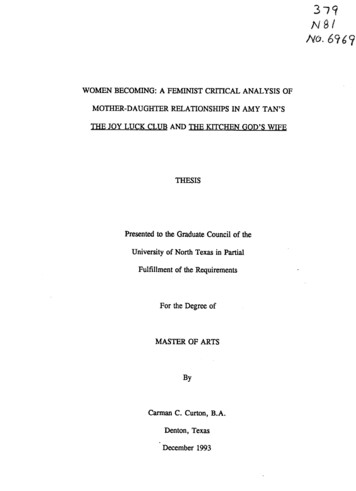
Transcription
3 -7NO,WOMEN BECOMING: A FEMINIST CRITICAL ANALYSIS OFMOTHER-DAUGHTER RELATIONSHIPS IN AMY TAN'STHE JOY LUCK CLUB AND THE KITCHEN GOD'S WIFETHESISPresented to the Graduate Council of theUniversity of North Texas in PartialFulfillment of the RequirementsFor the Degree ofMASTER OF ARTSByCarman C. Curton, B.A.Denton, TexasDecember 1993
Curton, Carman C., Women Becoming: A Feminist Critical Analysis of Mother-Daughter Relationships in Amy Tan's The Joy Luck Club and The KitchenGod'sWife. Master of Arts (English), December, 1993, 61 pp., bibliography, 56titles.This analysis of Tan's first two novels reveals that her female characters sufferfrom the strains critics like Amy Ling say result from the double paradox offillingthe roles of mother or daughter as minority women in a white, male society.Recognizing this double paradox offers Tan's characters, and her readers,theopportunity to resolve the conflicts between mothers and daughters in TheJoy LuckClub. Using the theories of psychologist Kathie Carlson helps readers understandhow the protagonist of The Kitchen God's Wife resolves similar conflictswith herdaughter and her own mother by seeking support from a mythic mother-figure,aGoddess of her own making.
Copyright byCarman C. Curton1993iii
TABLE OF CONTENTSCHAPTER 1.1.1.2THE MINORITY WOMAN ASMARGINALIZED WRITERCHAPTER 2.PARADOX IN THE MOTHERDAUGHTER RELATIONSHIPCHAPTER 3. . . . . . . . . . . . . . . . . . . . . . .HEALING THE WOUND: THE IRONYOF PARADOX IN THE JOY LUCK CLUBCHAPTER 4. . . . . . . . . 36MYTH-MAKING AS EMPOWERMENTCHAPTER 5LADY SORROWFREE: SELF-EMPOWERMENTIN THE KITCHEN GOD'S WIFE45CHAPTER 6.0.54. .a.0. . .0. . . . . . . . . .0.a.0. . .THE WRITER AS PROPHETWORKS CITED.0. . .0. .4. . . . . . . . . . . . . . . . . . . .iv57
CHAPTER 1THE MINORITY WOMAN AS MARGINALIZED WRITERAmy Tan's novels, The Joy Luck Club and The Kitchen God's Wife, focus onthe relationship between mother and daughter. These novels, stories of ChineseAmerican women written by a Chinese American woman,' portray in sharp relief theconflicts minority American women face in their daily lives and in their relationshipswith each other. In patriarchal societies, social expectations of female roles dividemother and daughter. Some critics assert that these forces further separate mothersand daughters who are also members of a racial or ethnic minority because expectedfemale roles are stricter and options for escaping or surpassing these roles are fewerfor such women. In these two novels, the female characters come to understand thatonly by recognizing and accepting the importance of their own mother-daughterrelationships can they come to terms with the paradoxes that inform their daily lives,the paradoxes and internal conflicts of women living in a man's world, of non-whitesliving in a Caucasian world. The viewpoints of Tan's female characters have beenhoned by their estrangement from American culture--both as women in a patriarchalsociety and as Chinese Americans in a Caucasian society. Being doubly-outside1 As writers including Amy Ling, Merle Woo, and Mitsuye Yamada use the nonhyphenated terms Chinese American and Asian American when referring tothemselves and others, I do also.1
2society has made these characters doubly-suited to make sharp observations and toprovide cutting commentary about the inconsistencies, absurdities, and tragedies thatfill their lives.The importance of the mother-daughter relationship is a distinct sub-topicwithin the realm of feminist literary criticism. Josephine Donovan considers it in herdiscussion of the tenets of feminist theory (ET 159, 211), and many other writers,essayists, and critics whose works appear in anthologies of writings by ethnic andminority American women focus on the topic as a matter of course. Essays, shortstories, and poems addressing the mother-daughter relationship fill collections such asThis Bridge Called My Back: Writings By Radical Women of Color and TheForbidden Stitch: An Asian American Women's Anthology.Devoting an entire book, BetweenWorlds, to Chinese American womenwriters, Amy Ling theorizes that being outside a culture offers a writer a uniqueperspective into that culture. She says that being doubly-outside a society, being awoman in a man's world, being a Chinese among Caucasians, offers writers a rarevantage point for examining a culture to which they both do and do not belong (1779). However, Ling does not focus solely on the unique perspective of the ChineseAmerican female writer. Rather, she emphasizes that, for writers on society'smargins, writing is more than mere expression. For the writers Ling examines,writing is "the affirmation of self in opposition to all forms of domination andnegation" (170). Ling says the explosion of ethnic and minority women writers ontothe contemporary American literary scene results from a "need to voice themselves"
3(179) and calls their writing "an act of self-assertion" and of "defiance against theweight of historical and societal injunctions" (1). Ling's recognition of the culturalforces that shape literature fits Elaine Showalter's definition of gynocriticism, that is,criticism that approaches minority women's writing only in context with the dominantculture which must influence it (462, 473).Some minority women writers utilize their marginal status to examine themother-daughter relationship and offer a viewpoint from which to reconcile thepsychological conflicts that some theorists consider inherent in such a bond. Onlyfrom this marginalized a perspective, assert such critics as Mary Daly ( GE 39, 347),Natalie M. Rosinsky (290), and Nan Bauer Maglin (258), can a reconciliationbetween mother and daughter be recognized, voiced, experienced, and honored.Tan's first two novels perform all of these tasks by focusing on the vitalrelationship between mothers and daughters. The Joy Luck Club utilizes the conflictinherent in the paradoxes of this strained relationship to reconcile the differencesbetween mother and daughter. In The Kitchen God's Wife, Tan illustrates how awoman can both empower herself through the act of creating her own mythicalgoddess and resolve conflicts with her daughter and her own mother, conflicts arisingfrom social and cultural pressures on both women in their roles as mothers and asdaughters.Psychotherapist Kathie Carlson says the "primary" relationship among womenis that between mother and daughter (xi). Yet, she says, for many women, thisrelationship is rife with grief because of the superhuman, even inhumane, expectations
4modern American society places on mothers to be flawless role models andacculturators for their daughters. Psychoanalyst Nancy Chodorow reaches the sameconclusion, asserting that certain cultural factors found in patriarchal societies createan emotional paradox by encouraging women to form strong emotional attachments totheir mothers, attachments which are degraded and devalued by other cultural factors.Chodorow says mothers and daughters tend to form closer bonds very early in thedaughter's childhood than mothers and sons do, because the women are united bytheir simultaneous identification with each other as family members and as females.However, this theory assumes that since sons do not form such close ties with theirmothers, they do not form them with anyone--mothers or fathers or siblings. Theseboys, and the men they then become, place little value on such close bonds as thosebetween mothers and daughters and, by association, assign little value to the womenwho share these bonds as well. The paradox these conflicting attitudes form pervertsand distorts the relationships mothers and daughters share.Does this cross-disciplinary analysis provide a valid paradigm with which tostudy Tan's first two novels? These social and psychological theories can be unifiedwith the assertion that women's writing is important because it validates theexperiences of female existence. Women's writing is "authentic" (Showalter 458;Register 12, 19) if it utilizes experience and emotion to create literature that tells astory relevant to an audience of women. The Joy Luck Club and The Kitchen God'sWife, then, will fulfill the requirements of authenticity if they are examined from theperspective of a variety of fields and stand up to the test, demonstrating that they
5speak accurately to and about women and the lives of women. By implication, thisliterature will be free of demeaning stereotypes and imprisoning assumptions offeminine inferiority. Register expresses this belief when, as part of her formula for"prescriptive" criticism, she says, "Rather than being driven to mental breakdown orsuicide or immobility, the heroines of new feminist fiction will somehow manage toresist destruction, perhaps with the support and confidence of other women" (24). Itis such women-supporting-women relationships, particularly the relationship betweenmother and daughter, that many feminist theorists see as vital to the stories womentell. Tan's first two novels portray just such strong mother-daughter ties, strained butloving, nurturing, and nourishing, nonetheless. The mothers and daughters in thesetwo stories feel the strength of their bonds and fight to cross the chasm of conflict andmisunderstanding that separates them.Are the feminist theories from the various disciplines cited here solidly linkedto feminist literary criticism? A wide variety of scholars assert the answer is "yes."Critic Terry Eagleton is unequivocal in stating that all critical theory is politicalbecause it either seeks to transform society or it strains to uphold the status quo (195).He even goes so far as to upbraid literary critics who either desire or claim to beapolitical, since, he argues, any culture's canon can easily be shown to serve theinterests of those who are privileged to name that very canon. As Betty Friedan sosuccinctly states, "aesthetic criticism can't be value-free" (54). Eagleton and RolandBarthes each equate the terms culture and ideology (Eagleton 195; Barthes 81).Barthes says that the critic who caims to practice his or her trade without a political
6agenda, doth, like the Queen in Hamlet's play, protest too much. Barthes asserts, "aliterary judgement is always determined by the whole of which it is a part, and thevery absence of such a system--especially when it becomes a profession of faith-stems from a very definite system" (82). Eagleton affirms this, saying "ideology" isthe "connection" between discourse and power (210).Affirming the link of culture to ideology, both Michel Foucault and ElizabethMeese assert that truth cannot be determined independently of power. For Foucault,what is "true" depends on who controls the discourse (72-3). Meese follows thisreasoning to its logical end by concluding that male domination of discourse,including literary and critical discourse, traps women inside male "truth" (Meese 16).Raman Selden draws the same conclusion, asserting that literary values andconventions have been shaped by men to apply to men's writings (136). Showalternames the sum of these conventions "male critical theory" even as she recognizesthat, until the advent of modem feminist criticism, such theory, primarily conceivedof and espoused by men for literature by men, was considered "universal" anduniversally applicable to all literature written by and for all people (46).Donovan calls feminist political theory "central" to feminist critical theory(ELC, x), and Cheri Register asserts that feminist critical theory is a "new" form ofliterary analysis founded on the "tenets" of the American women's movement" (1),stating that it is "ultimately" cultural analysis (10). In defining feminist criticism as"rebellion" against and "resistance" to the male bastion of the literary canon (458),Showalter coins the term "gynocritics" (461) and, in calling for a redefinition of
7criticism, connects feminist criticism irrevocably to cultural criticism. Thus, byasserting that no literary criticism can remain apolitical, these scholars haveestablished a link with which to connect feminist cultural theory to feminist literarytheory.Since a number of writers, critics, and academicians concur that feministcriticism has its roots in feminist theory, it is important to establish a workingdefinition of feminism. Again, a common definition is difficult to recognize sincethere exist nearly as many definitions as critics.The point of agreement among the seemingly myriad of theories ofcontemporary American feminism is a recognition that women in American societyshare a "disjunction" separating them, as feminine, from the common culture (Hunt11). Feminist theorists as diverse as Donovan, Ling, Mary Daly, Ann WilsonSchaef, and Merle Woo recognize that women's experiences are defined as outside therealm of relevant experiences, outside a reality determined, more precisely, as malereality. Such theorists acknowledge that, for men and women alike, women arealways Simone de Beauvoir's "Other" (29).Donovan calls much feminist literary criticism "corrective criticism." She seesthe goal of this criticism as, generally, focusing the theoretical spotlight on"feminine" reality and, specifically, correcting the male bias feminist theorists believepervades literary criticism (Crit. Ing. 605). Like Donovan, Register also definesfeminist criticism as a form of analysis based on the principles of feminist politicaltheory and presents a detailed outline of the male bias she sees in current literary
8theory. Register's criticism prescribes standards for writing with a feminist viewpoint(2). The goal of such prescriptive criticism is to provide an impetus for authors tocreate a new literature and for critics to provide a new literary standard whichpresents and analyzes valid images of women and women's lives. Register'sdefinition of validity includes a requirement of "authentic[ity]" found in the "realisticrepresentation of 'female experience,' 'feminine consciousness,' or 'female reality.'"Presenting an argument for a phenomenological reading, Register states that onemeasure of such authenticity "must be the subjective response of the female reader,"using, as the yardstick for comparison, the reader's own experience of femininereality (13). Thus, she asserts, women's literature should "compass the totality of thefemale life experience" (19). Showalter reaches the same conclusion in herdescription of feminist criticism as an act of rebellion against existing (read: male)critical theory. Here, she insists that feminist criticism should be based more onwomen's studies than on English studies (460) and asserts that feminist studies rejectsupposedly objective standards of literary criticism based on the male canon and malecriticism in favor of accepting the "authority" of female experience (458).From this theoretical base, then, it is a short step to a theory of feministcriticism as, first, a recognition of the validity of women's experiences as well as ofwhatever mode women use to convey their originality, their uniqueness, and theirgenuine thoughts (Showalter 461, 473). Alice Walker pays moving tribute to thisindividuality in general, and to her own mother's in particular, in her widely cited "InSearch of Our Mothers' Gardens" (231-243). Donovan goes beyond reverence for
9this recognition of women's experiences to call the study of women's literature"empowerment" (Donovan FLC, xiii). This theory of feminist criticism alsoembraces the idea that certain topics are vital to any valid literary account of women'sexperiences. Eagleton concurs, asserting of the feminist critic, "She also believes thatgender and sexuality are central themes in literature and other sorts of discourse, andthat any critical account which suppresses them is seriously defective" (209).In "Letter to Ma," Woo affirms the importance of bringing strong motherdaughter relationships to light once again. She says it is "crucial" to put women'sstories in writing, especially stories of ethnic American women and of therelationships between ethnic American mothers and daughters (146). The messagesthese stories convey--that many minority mothers and daughters share seeminglyirreconcilable differences, that these differences can be used to strengthen thisimportant bond--are part of a growing awareness that women cannot ignore theimportance of a mother and of mothering in their lives. Karen Elias-Button says thesource of women's self-discovery is a "personal" as well as a "mythological"reexamination of women's relationships, not just with their mothers, but with themythological figure of the mother-archetype as well (193). Tan's characters in TheJoy Luck Club and The Kitchen God's Wife discover new strength and vitality withintheir own mother-daughter ties. In the process of learning and re-learning aboutthemselves and each other, these women also re-evaluate and re-recognize the valueof being mothered, whatever the source of this care and nurturing. Judith Ochshorndocuments stories of strong mother-daughter relationships found in ancient Near
10Eastern literature and says tales of satisfying relationships between strong andindependent women could only have been created in a time when women were"valued" and their relationships to one another considered valid and strong. Themessage implied in her essay is that literature portraying similar bonds is rarelyvalued in modern American culture because such woman-to-woman relationships arerarely appreciated (5-14). Daly says, much more emphatically, that "feminismreleases the inherent dynamic in the mother-daughter relationship toward friendship,which is strangled in the male-mastered system" (G/ 39).If Daly further defines feminism as "the journey of women becoming," (/ E1), then feminist literary criticism could be named the analysis of women's writingthat reveals the story of women becoming. The writers, scholars, and theoristspresented in this chapter agree that the primary value of women's writing is itspresentation of the journey of the female experience, a presentation which needn't beheld up to the literary canon of predominantly white, male writers and judged deviantor be analyzed by dominant schools of criticism and judged inferior. Archaeologistsare now reconstructing ancient stories and myths that celebrate the power andsensuality and sacredness of women, as females, as sexual beings, and as mothers anddaughters (Gadon 285-307). New feminist writers are now reconstructing similarstories in their literature. Donovan believes that power and politics are embedded inall of our actions (x). In The Joy Luck Club and The Kitchen God's Wife, authorAmy Tan empowers women through the resolution of paradox and the creation ofmyths that serve today's ethnic American women.
CHAPTER 2PARADOX IN THE MOTHER-DAUGHTER RELATIONSHIPIn a patriarchal society, paradox is a daily part of a woman's life. The traitswhich American culture values most lie in direct opposition to the American ideal ofwomanhood. Success and achievement are unbecoming to a woman, and even moreso to a woman who is also a mother. Yet the woman who is not a mother, by chanceor by choice, is seen as flawed or at least suspect. So central is motherhood to theconcept of female in such a society that a childless woman is seen as essentiallyflawed. Barthes notes in one of his Mythologies essays that a popular Frenchmagazine profiling women writers had to resolve the conflict presented in honoringthese women's literary accomplishments by listing their achievements side-by-sidewith a photo of their children. Since achievement and recognition violate societaldefinitions of femininity, juxtaposing success with children relieves the discomfort areader might experience about these writers' accomplishments if he or she is notreassured that they are mothers first and writers only after that. Yet in a patriarchalsociety, the woman who fills the role of mother faces unattainable expectations. It isoften a thankless, no-win position, and still a woman must prepare her daughter tobecome a mother herself if the mother is to fill her own expected role in society.The ironies inherent in the lives of women are multiplied for the women ofcolor in such a culture. Paradox intensifies when a women who already holds a11
12tenuous position within a society is further marginalized and faces additional conflictsin role expectations as a member of an ethnic or racial minority. Women in suchcircumstances are often poor and undereducated and face conflicting cultural demandsfrom their dual heritages. Pressures on ethnic and minority women to conform to"feminine" roles are even stronger and more numerous than those on their Caucasiancounterparts (Rosinsky 280).This abundance of identity conflicts calls to mind Karlyn Kohrs Campbell'sassertion that, since the feminist voice is by definition "a violation" of the femininerole in western society, the only suitable metaphor for the rhetoric of the women'smovement is the irony of paradox ("Feminist Approach" 389-402). Campbell notesthat the "fundamental" values of American culture--"self-reliance, achievement, andindependence"--are in direct opposition to the definition of the female role--"gentle,""soft," and "delicate" ("feminine"), "cute" and "helpless" (Friday 35), passive andcompliant (Ellman 78-81; 119-23).For every American woman, then, assuming therole of speaker, using one's voice in speaking or writing, is in itself a paradox.The core of a paradox, however, is that such an "apparently self-contradictory(even absurd) statement" contains at its center "a truth reconciling the conflictingopposites" (Cuddon 479). What do paradoxes convey, then, except a puzzle? Theanswer to a paradox, its meaning and purpose, is found within the "truth" of itsseemingly irreconcilable conflicts. However, it is not necessary to view suchconflicts as negative. A Feminist Dictionary's citation identifies "conflict" as anessential component of growth. This definition also includes the concept of conflict
13as a "process" of moving on, or as a transition from an "old" belief to a "new" one(104). Using such a methodology, the many cultural and situational paradoxes withinTan's The Joy Luck Club can be examined. A close reading of these paradoxesoffers the reader a new understanding of the many ironies in the lives of the book'seight female characters. Reconciling these paradoxes helps a reader trace a pathparallel to that which the Joy Luck Club characters follow as they solve the conflictsbequeathed them by their social and ethnic heritages.Such conflicts can be found at the heart of the paradoxes that define the rolesthe Joy Luck Club characters play. These eight characters--four mothers and theirfour daughters--face seemingly irreconcilable conflicts about their familial roles aswell as about their roles in American society as Chinese Americans. These womenparticipate in the process of resolving personal, familial, and cultural dilemmasarising from their positions as Chinese Americans in a Caucasian society and asmothers and daughters in a patriarchal society. By doing this, they resolve theparadoxes of their lives as women and as Chinese Americans.For the many women who are also mothers, the paradoxes of women's rolesgrow as these mothers constrict their daughters' growth. Mothers mold theirdaughters physically and emotionally to the restrictive ideals of femininity that societydemands of women for their survival. For the daughters, too, paradoxes aboundwithin their development as they try to form their first ideals of self-identification inopposition to their mothers, their first role models. Daly details conflicts daughtersdevelop with mothers whose societal duties demand that they teach their daughters to
14conform to appropriate female roles. In Qyn/ oQgy she closely examines themother's role in preparing her daughter to conform to the restrictive and objectifiedplace to which society relegates her.Carlson devotes an entire book to the ancient and transcendent motherdaughter relationship, discussing millennia of troubled mother-daughter ties. Carlsondescribes a view of motherhood where both mother and child have unrealistic,unrealizable expectations for the role of mother as well as for the person filling thatrole. The paradox here rests in how such a vital role in any society can be so easilyreduced to a lose-lose situation. Throughout the pages of In Her Image: TheUnhealed Daughter's Search for Her Mother, Carlson argues that the complex andundervalued mother-daughter attachment is further complicated in cultures that do nothave a female god-image or archetype which women, mothers and daughters alike,can turn to as a model Mother (73). Carlson explains that cultures which worship apatriarchal god or gods offer to men and boys an alternate father-figure which canserve their emotional and self-identification needs in a variety of ways. First, fathergod figures can provide both a model and an ideal toward which fathers within aculture can strive. A second benefit to the men and boys of a society which proffersone or more revered masculine gods is the option of turning to an alternate fatherfigure. If a son finds his relationship with his own father lacking, he can choose toturn to the father-god and utilize this figure and its surrounding religious institutionsas substitutes for the parental nurturing and guidance missing from his life (3). Thethird and most important benefit of a revered father-god to the men of a culture is the
15clear delineation between the father-parent and the father-god for every member ofthat culture. Carlson's point is that a child doesn't consider a father an archetype-omniscient, all-powerful, responsible for supra-natural matters in life and in death--ifanother father-figure which models these powers is already present in the culture (10).Carlson draws on this analytical framework to explore the effects on women ofliving in a culture where no similar respected and revered female models exist. Sheasserts that in a society where the concept of Mother and the actual mother are notmodeled separately, the two ideas merge. Carlson then outlines why viewing one'smother as indistinct and inseparable from the archetype of Mother is a recipe forfailure. Such a merged view of mother and Mother, she says, creates unrealisticexpectations of mothers as well as of mothering (3-12).'Carlson writes that, in such societies, both a mother and her children holdunattainable ideals of motherhood. The primary result of these unrealisticexpectations for a mother is, according to her, guilt. Since no one can be as perfectlyloving, giving, and nurturing as a goddess, she argues, every mother in such a societywill always carry the burden of her own inadequacy as a mother (65).The"dynamics inherent in the patriarchal" system of child-care, Carlson says, encourage' While some critics would posit the Virgin Mary as an accessible and positiveMother in many cultures, Elinor Gadon presents a detailed account of Christianity'sefforts to continually sanctify an image of the asexual Mary. She argues that the cultof the immaculate conception of the Virgin and the miraculous conception of Christhave served to separate the idolatry of Mary from the "sacredness of humansexuality." This contributes to the paradox-filled roles of mother and daughter, sinceno woman can achieve Mary's purity if that woman were a mother or even aspired tobe (189-223).
16the child and others to see a mother as the willing "all-fulfiller" of needs who is,ideally, "unselfish" and "infinitely caring." Additionally, if a boy in such a societyfinds his mother unequal to the task of her idealized role, he can turn to his father orto his father-god figure for guidance about his place within his culture. A daughter inthis position, however, has no such alternative (3). The unresolvable conflict in thissituation, the paradox here, is that the role of mother is vital to any society that wantsto last beyond one generation, yet it is a role whose expectations no single person canever fill.Chodorow also considers social and cultural factors primary influences on themother-daughter relationship. However, Chodorow attributes gender differences inpersonality development to the tendency in nearly all cultures for women to beresponsible for early childhood care. She asserts that by about age three, young malechildren experience early separation and personality differentiation in identifyingthemselves as masculine and apart from their mothers. By contrast, Chodorow states,mothers see their daughters as like themselves, and a typical mother begins "toexperience her daughter. as herself" (46).2 She asserts that the motherconsequently treats her daughters differently from her sons. Daughters, likewise,view themselves as like their mothers, and so do not experience early separation fromtheir mothers during identity formation, the first self-knowledge which childrenCarlson also recognizes this dual identification among the women she treats inher private practice as a psychologist (23-33).2
17develop around the age of three (51). In other words, female children, inChodorow's estimation, are more likely to view themselves, and consequently tovalue themselves, in relation to perceiving other peoples' needs and feelings(beginning with their mothers') as their own (58-9). Separation conflicts andproblems in developing a sense of identity, self, and role seem almost inevitable forgirls and women in such families and cultures.Other mother-daughter conflicts are brought to the fore throughout the processof a daughter's socialization as well. As Carlson, Chodorow, Donovan, and othershave noted, mothers have been children's primary caregivers in most of the world'scultures throug
This analysis of Tan's first two novels reveals that her female characters suffer from the strains critics like Amy Ling say result from the double paradox of filling the roles of mother or daughter as minority women in a white, male society. Recognizing this double paradox offer
